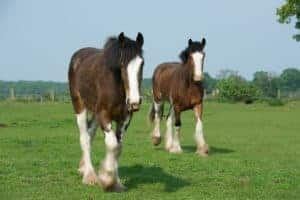Prevalence of, Risk Factors for Ulcers in Jumpers Examined
Equine athletes of all disciplines are at risk of developing gastric ulcers. Commonly associated with poor appetite, attitude changes, and other issues, these digestive tract disturbances can also cause a decrease in performance. As a result, researchers have evaluated their prevalence and risk factors for a variety of disciplines, including racing and endurance riding. But a Canadian research team recently took a closer look at gastric ulcers in another common group of sport horses: show jumpers.
Sarah Pedersen, DVM, now a fellow at TD Equine Veterinary Group, in Calgary, Alberta, Canada, presented the results of their study at the 2015 American College of Veterinary Internal Medicine Forum, held June 4-6 in Indianapolis, Indiana.
Ulcers can develop in both the squamous (top) and glandular (bottom) portions of a horse’s stomach. The lower glandular part of the stomach contains a mucosa with glands that secrete acid and pepsin, which are important aids in early food digestion. The glands also produce bicarbonate and mucus, which help form a protective barrier over the mucosal surface. This protects the glandular stomach from acid and pepsin’s damaging effects. The squamous region, however, has few defenses and is particularly susceptible to injury caused by stomach acid (i.e., ulcers).
“Previous research has focused primarily on risk factors for squamous ulcers, while the role of specific risk factors in the development of glandular ulcers remains unclear,” Pedersen said
Create a free account with TheHorse.com to view this content.
TheHorse.com is home to thousands of free articles about horse health care. In order to access some of our exclusive free content, you must be signed into TheHorse.com.
Start your free account today!
Already have an account?
and continue reading.

Related Articles
Stay on top of the most recent Horse Health news with

















